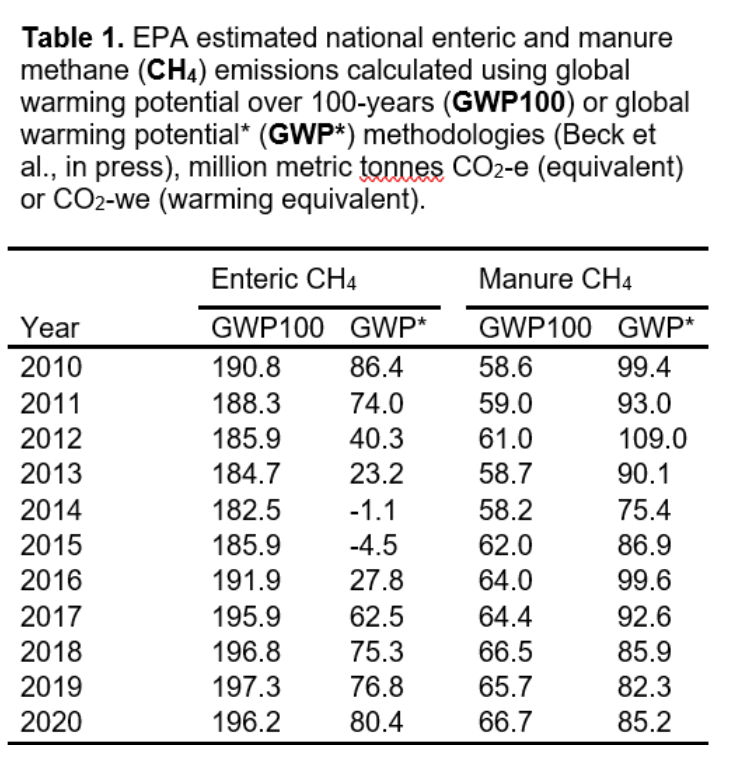Logan Thompson, Sustainable Grazing Systems
Today, the beef industry is increasingly facing calls to act on its perceived impact on climate change and other negative ecological impacts that occur from production activities. This includes greenhouse gas emissions, soil degradation, eutrophication of water ways (accumulation of nitrogen, phosphorus and other nutrients) and a decrease in biodiversity. It may come as a surprise to some that the largest source of greenhouse gases from beef production arises from our grazing operations. Chiefly this is from the cow-calf sector and primarily in the form of methane produced during the ruminal fermentation process (Rotz et al., 2019). If we consider that methane production is primarily driven by level of intake and quality of the diet, then this does make sense as many cows are grazing for the entire year, generally, all the while consuming a lower quality diet than fed in confinement operations and weaning approximately 0.85 calves per cow exposed per year. However, these estimates may not tell the complete story of the ecological niche that grazing cattle play in our grassland ecosystems or how their emission estimates compare to historical or current wildlife populations.
Recently, there has been a new method to calculate the climate warming impact of short-lived greenhouse gases (atmospheric lifetime of 9 -12 years), of which methane is one (Lynch et al., 2020). The new method, denoted as GWP* (Global Warming Potential, also referred to as CO2-warming equivalent), considers this short lifetime when calculating climate impacts of methane by comparing the relative rate of change of emissions over a 20-year window. For example, if the relative rate of emissions today is less than it was 20 years ago, then a “cooling” impact would be observed. Recently, we compared the U.S. beef and dairy industries climate impact by recalculating the U.S. EPA greenhouse gas inventory using this new metric and the standard global warming potential method (Table 1; Beck et al., in press). We found that, while enteric (relating to the intestines) emissions have remained relatively constant from 1990 to 2020, manure emissions were a larger contributor to climate warming than enteric methane (a byproduct of fermentation in the rumen; 90.8 vs. 49.2 million metric tonnes CO2-warming equivalent, on average). Further, using GWP*, beef production actually provided a cooling effect from 2013 through 2016 for enteric methane emissions compared to the considerable source of warming calculated using the standard global warming potential metric. Therefore, utilizing this new accounting method, which more aptly captures climate warming impacts compared to standard accounting, provides the potential for the beef industry to have a “cooling” effect on the climate. This may provide economic incentives to change/alter management to capture this impact.
Another underappreciated aspect of beef production and emissions from grazing systems is the lack of a natural baseline by which to compare current livestock emission rates. There have been efforts to estimate historical wildlife emission estimates in North America compared to current livestock species (Hristov, 2012). Hristov (2012) calculated greenhouse gas emissions of North American wildlife pre-European settlement. With bison populations estimated at 20 to 75 million head, it was projected this population emitted 73.6 to 166.1 million metric tons of CO2 equivalent emissions per year, compared to 134.1 for U.S. ruminants in 2011. Similarly, in an effort to gauge a current baseline of wild herbivores and livestock species, Manzano et al. (2023) compared wild herbivore populations within the Serengeti to livestock populations in the Loliondo game-controlled area of Kenya. They estimated that for wild herbivores and livestock species, the emissions were 76.2 vs. 76.5 lb CO2 equivalents per square mile per year. These efforts at baselining our current emission estimates indicate that, potentially, our current ruminant production practices are within the range of wild populations which would replace the livestock species in grassland ecosystems if the landscapes were not utilized for agriculture.
Lastly, while we appear to be part of the climate solutions, there are still production benefits to reducing greenhouse gas emissions, particularly enteric methane emissions. Enteric methane represents a loss of consumed dietary energy and by working to reduce this we could see improvements in animal performance. In grazing systems, the largest source of enteric methane, efforts to reduce enteric methane are challenging as this sector is one that has the least precision in what and how much animals are consuming. Therefore, focusing on management strategies that improve the quality of the forage base on the ranch is the most practical avenue to reduce enteric methane production. This includes practices such as utilizing adaptive or rotational grazing, incorporating high-quality forages when possible, and improving forage diversity. However, these strategies are highly dependent on geographic location and require regionally specific research to fine tune these strategies. Additionally, management strategies that focus on maintaining a high quality and productive forage base may lead to other beneficial outcomes such as carbon sequestration and soil health (Thompson et al., 2023). Therefore, potential “win-win” outcomes may be achieved.
Citations:
Beck, M. R., L. R. Thompson, J. E. Rowntree, T. N. Campbell, J. A. Koziel, S. E. Place, and K. R. Stackhouse-Lawson. In Press. U. S. manure methane emissions represent a greater contributor to implied climate warming than enteric methane emissions using the global warming potential* methodology. Frontiers in Sustainable Food Systems.
Hristov, A. N. 2012. Historic, pre-European settlement, and present-day contribution of wild ruminants to enteric methane emissions in the United States. J. Anim. Sci. 90:1371-1375. doi: 10.2527/jas.2011-4539
Lynch, J., M. Cain, R. Pierrehumbert, and M. Allen. 2020. Demonstrating GWP*: A means of reporting warming-equivalent emissions that captures the contrasting impacts of short- and long-lived climate pollutants. Environ. Res. Lett. 15. doi:10.1088/1748-9326/ab6d7e.
Manzano, P., A. del Prado, and G. Pardo. 2023. Comparable GHG emissions from animals in wildlife and livestock-dominated savannas. NPJ Climate and Atmospheric Science. 6:27. Doi: 10.1038/s41612-023-00349-8
Rotz, C. A., S. Asem-Hiablie, S. Place, and G. Thoma. 2019. Environmental footprints of beef cattle production in the United States. Agric. Syst. 169:1–13. doi:10.1016/j.agsy.2018.11.005. Available from: https://doi.org/10.1016/j.agsy.2018.11.005
